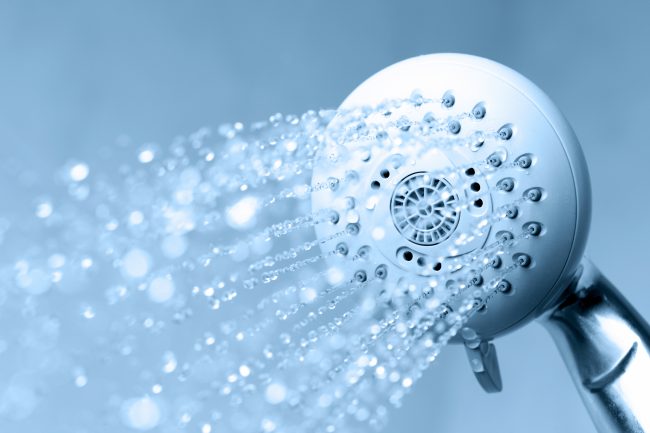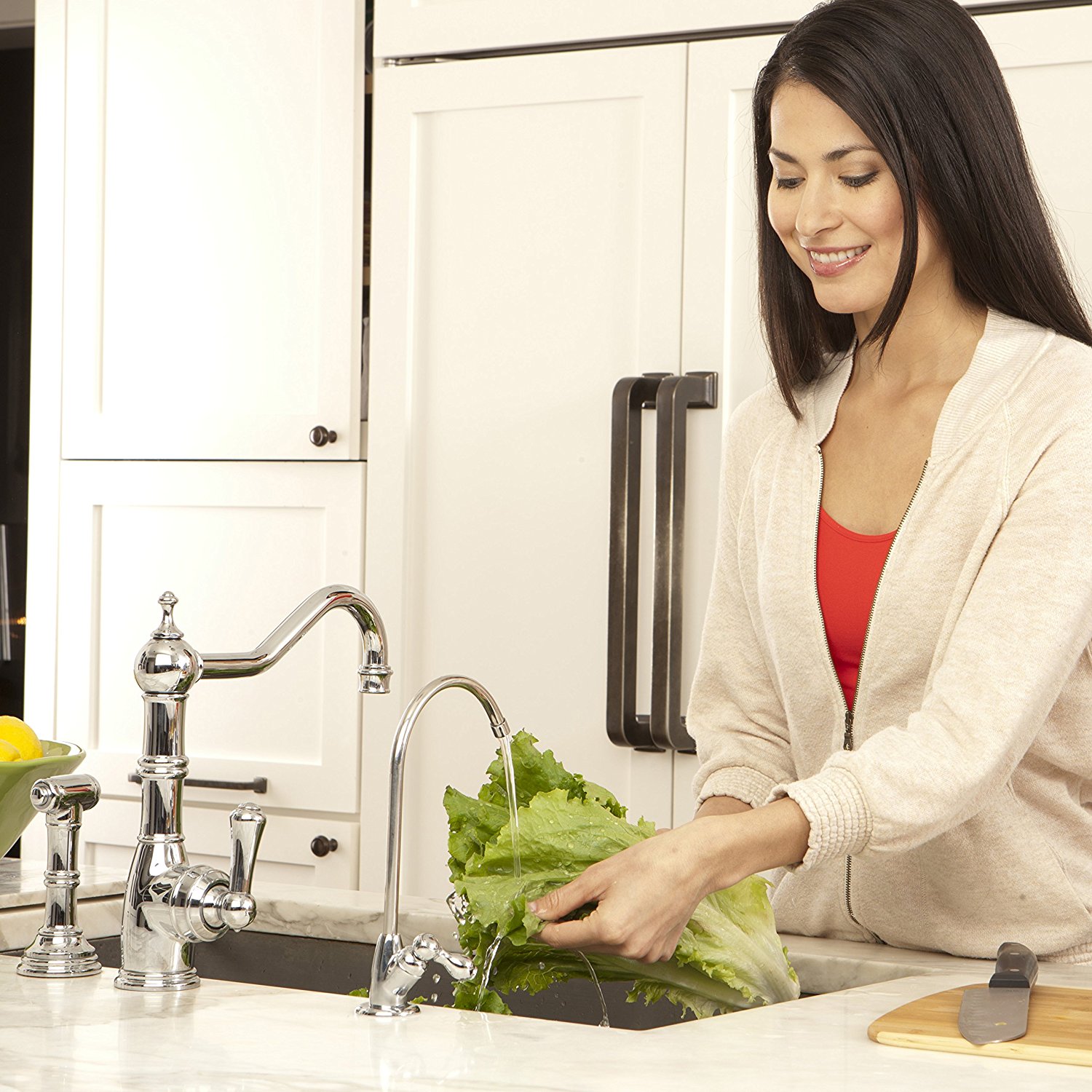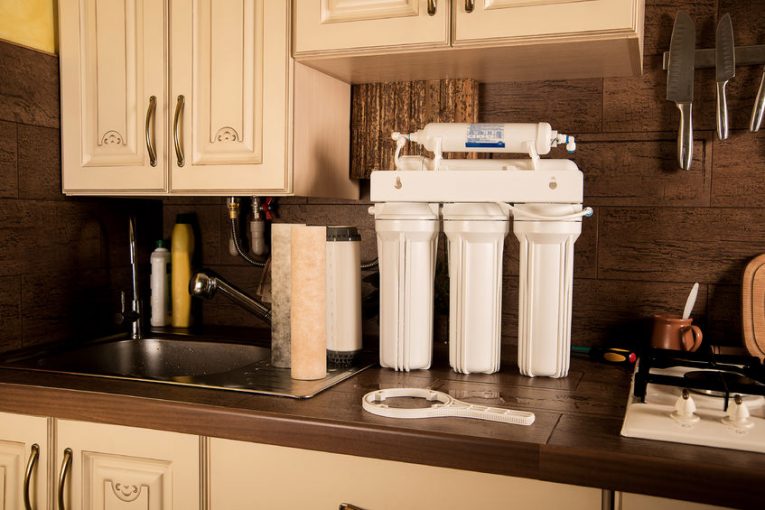
It’s a new year, consumers are recovering from Christmas expenditures, and Spring is on the way. It’s a good time to consider options for filtering one’s water over the rest of the year, especially with some systems boasting 12-month filters. So, the question remains: what is the best reverse osmosis system that will meet your filtration requirements?
We’re about to look at what reverse osmosis systems the market has to offer. These products, albeit rather closely priced, will be grouped and considered in three prices ranges:
- Systems in the range of $200 and under
- Systems in the $200-300USD range
- Systems in the range of $300USD and upward
It’s also worth examining value-for-money considerations. Accordingly, we’ll compare the products across all price-ranges after reviewing each group to see the best system(s) overall.
The reverse-osmosis market has to be understood for what it is if the comparisons are to make sense. Domestic RO has particular attributes, both strengths and weaknesses, which bear a mention before we start.
Reverse Osmosis Systems, especially multi-stage RO systems, are strong on
- Thorough filtration
- Relative flavor and odor of water yielded
Some systems even remineralize the water post-filtration.
They’re generally not good for
- Flow-rate
- pH for drinking water
- Supplying water at high pressure
- Water conservation
- TDS creep
Flow rate is less of a priority with domestic reverse osmosis (RO), since slow flow rates come with the territory. Household RO systems, by their nature, have a creeping flow rate, even those with the fastest flow-rates.
RO is restricted to under-sink installation, rather than directly into the main water supply. Due to low pressure and flow-rate, RO isn’t good for whole house systems. That’s before we even consider chlorine removal, which can allow harmful microbes to thrive in the pipes and makes this kind of filtration system more appropriate at or just before the faucet.
They also yield little usable water compared with other filtration systems and it’s a small fraction compared with waste water (usable water being at most 15% of what passes through the system but often 5% or a little lower, in practice). Supposing your mains water supplier is expensive, the waste water alone might rule out RO as a practical choice.
In other words, if you’re looking to recover as much water as possible at a decent pressure and flow-rate, RO is the wrong segment of the market for you. That said, some of the systems below will ameliorate one or more of the problems normally associated with RO. Accordingly, they can’t be dismissed out of hand.
Besides this, each and every one of these products now come with the option of professional installation from Amazon at a standard price of $152.92.
Finally, there’s one last (seemingly insubstantial) point to consider before we move on to the products themselves.
The Best Reverse Osmosis System that is ‘Made in America’: Is It Relevant?
Customers might notice the prominence of claims to being “made in America” or some similar phrasing — more prominent in some cases than others. Every single product reviewed below is either made in America or constructed with American materials; or else uses American-made filter cartridges and membranes — and in some cases, all of the above apply. In any case, it’s a recurring theme with the marketing of many systems, but it’s a lot more than empty bragging or cynical marketing.
There’s substance to the claims. Of course, it’d be remiss to deny out of hand the emotional, patriotic and, yes, political considerations of such marketing, but these are neither here nor there. Next to the other, purely practical and economic reasons, especially for domestic water filtration products, that (1) this marketing works; and (2) American-manufactured products as such really are a good investment for the customer.
Indeed, it makes sense once we consider the recent history of the filtration market versus other industries. Even while the general trend since NAFTA and even earlier has been that phrases like “American-made” and “Made in the USA” have become both increasingly less common and less valued, it’s a little different in the specific case of water filter production. American regulation is much more strict about what filtration manufacturers can lawfully claim about their products and how much testing is required to confirm this. Besides this, American filtration systems are more likely than non-American to be NSF-certified and the WQA, which gives its gold seal to the best filtration products of its members, is an American organization.
Unlike larger (heavier) industries, water filtration manufacture is a lighter industry on a smaller scale with less production turnover, which requires the best materials and expertise for production to continue at sustainable levels of quality. It’s a niche in American industrial manufacture, where many of the top companies are either locally based, family-owned or both, despite national or even international distribution. These interconnected factors have made it more resistant to offshoring than larger, lower-skilled, heavy industries. American manufacture is still the best in the world for high quality, high cost production — and the logical choice in a filtration market that is already highly competitive.
Likewise, American steel is a world leader in quality, corrosion-resistance and tensile strength. It’s still the preferred choice for the construction of products for industrial manufacture. This is why it’s used extensively in many systems with steel storage tanks, fittings and the like.
So, when you see this, there’s good reason for it; and while there’s an outward element of emotional appeal for home filtration newcomers in such expressions as “American made” or “US built” (even 100% US built), there are also plenty of cold, hard facts to make it a compelling selling point for even the more experienced and clear-sighted customer. This is why we find that this comes up again and again.
It’s relevant to these products, but since they’re all US-built, have American-made components or use US-sourced filters, without exception, they’re on a level playing field, so their other attributes will be decisive in evaluating their worth.
So, without further delay, here’s the first price range.
The Best Reverse Osmosis System for $200 and Under
Now we’ll look at the cheapest range of products reviewed. This may will be the first time you’re seriously considering an RO system for your home. For a customer trying an under-sink unit for the first time, under $200 isn’t a bad price-point at which to start and it’s certainly a good price-point to introduce customers to the market.
So, let’s start with the cheapest.
5-Stage Built In USA Reverse Osmosis System Water Quality Filter- NSF Faucet & Tank Plus Extra Set Of 4 Filters For Free
 Price: Check on Amazon
Price: Check on Amazon
Pros:
- Quick and easy installation with John Guest® Quick Connect fittings
- Filtration up to 99% for TDS, scale, sediment and harmful or unpalatable chemicals
- Also effectively anti-microbial, due to combined action of GAC filter and RO membrane
- Low priced — cheapest system reviewed
Cons:
- Eventual degradation of tubing and JG connectors is likely, also possible leaks from initial installation
For those who like thorough multi-stage filtration with the trimmings, Global Water’s 5-Stage RO system is a head-turner. It boasts top quality US-made components, easy installation, extras, spares and, if you buy through Amazon, professional installation (albeit at a price).
Installing this system is easy, with the Quick Connect fittings provided in the package by the manufacturer. In case you’re worried about leaks, you might be better to opt for the professional installation, although it’s probably not necessary.
The five stages of the 5-Stage Reverse Osmosis System offer progressive filtration of a range of solids and other contaminants:
- The first stage of filtration is the NSF 5-micron polypropylene filter, which removes a range of sediments, impurities and other particulates like sand, scale, mud and rust, among others.
- Second, the GAC (Granular Activated Carbon) coconut shell activated carbon filter removes chemicals like chlorine and others which cause unpleasant flavors and odors, as well as VOCs and other pollutants.
- The CTO 5-micron block carbon filter filters out more of the same at the third stage.
- The membrane, the RO proper of the RO system, filters at stage four. This high quality NSF reverse-osmosis TFC membrane filters out up to 99% of remaining contaminants, from salts and scale and other water-hardening substances, to heavy metals (including lead) and chlorine, fluorides and arsenic as well as other water soluble chemicals.
- Finally, for post-filtering, the inline cartridge reduces remaining contaminants for improved odor and flavor. By the time your water comes out of the complimentary faucet, the total dissolved solids (TDS) and the malodorous, unpalatable (and possibly harmful) chemicals in your water will be at a minimum.
The 5-Stage water filter is also a de facto anti-microbial system (though not certified for this application), eliminating bothersome micro-organisms between the action of the second-stage GAC filter and the RO membrane.
The system comes with the following filters: sediment (x2), GAC activated carbon (x2), CTO block carbon (x2), inline filters (x2), as well as a RO filtration membrane (x1). It also includes the steel tank and a faucet; the tubing, connectors and valves; and the manufacturer’s installation kit.
The relevant inventory for the manufacturer’s replacement filters on Amazon is limited to two products: the reverse osmosis filter itself at $14.44 and a three-pack of filters for three-stage filtration comprised of a sediment filter, a carbon 1-micron filter and a carbon NSF Standard 42 filter for $64.99. In any case, as a rule, the modular design of different manufacturer’s filtration systems means that they almost always fit each other’s cartridges because they’re made to a universal standard size for water filter cartridges. It’s worth bearing this in mind when looking at Global Water’s 5-Stage water filter is no exception, so customers needn’t be put off by limited options for same-brand filter cartridges.
This system uses NSF-certified components at different stages, namely the first polyprop cartridge and the faucet — and possibly more, if you customize the setup. In the home filtration segment of the market, NSF certification can be a dealmaker or dealbreaker.
All of this at a price tag of under $150 will probably pique the reader’s attention — and it should. It’s the cheapest system under review. Moreover, it has all the extras, including spare filters, and it has multiple redundancies for filtering both solids and chemicals.
It’s also built in the US, like the other systems reviewed below, so whether you like your dollars going toward domestic manufacture or simply want the reassurance of a product meeting American standards of filtration and construction materials mentioned above, Global Water’s 5-Stage system won’t disappoint.
For an additional premium, Amazon will not only deliver the system but commission professional installation for you. Granted, this doubles the price tag, but even with the installation included, the customer tops out at a little over $300. That’s not bad for the added peace of mind it gives to an inexperienced customer or at any rate the time and hassle it’ll save any customer.
All of the reviewed systems do, in fact, carry this same option of professional installation for the same price, but this system is the cheapest and makes this option more affordable.
iSpring RCC7 5-Stage Under-Sink Reverse Osmosis Drinking Water Filtration System – 75 GPD
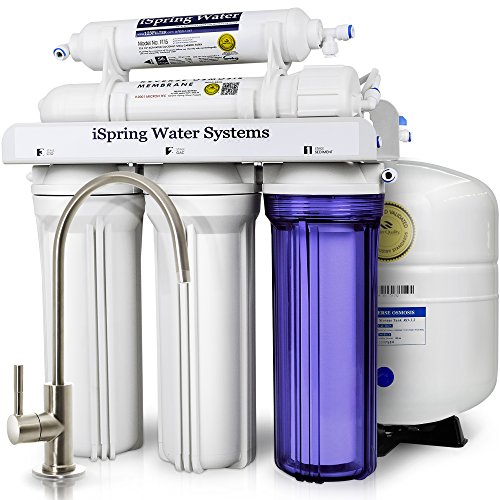 Price: Check on Amazon
Price: Check on Amazon
Pros:
- Excellent filtration, with two stages of GAC filtration (including post-filtration)
- Certified by NSF and gold certified by WQA
- Feed connection adapter fits both ½” NPT and 3⅜” COMP connecting pipes
- 75 gallon-per-day filtered supply
- Includes brushed-nickel-plated, solid brass, European-style faucet
- One-year money-back guarantee & one-year limited warranty
- Lifetime technical support
Cons:
- Insubstantial plastic fittings, prone to wear and leaks
- Most expensive in its range for slightly better performance
iSpring’s RCC7 is a wonderful little system. Installation is easy but even so, the feed connection is both sturdy and adaptable to either ½” NPT connectors or 3⅜” COMP ones for mains water supply. Its performance is certified by NSF International and it’s gold certification by the Water Quality Association as well.
The RCC7 has five simple but effective stages of filtration.
- The first stage, as expected, is a sediment filter for particulates and larger solids.
- Second, there’s a GAC activated carbon filter.
- This is followed by a CTO carbon block filter at the third stage.
- Stage four is where the water’s filtered through the RO membrane itself.
- After the membrane, for the fifth stage, the RCC7 uses a second (and even finer) GAC filter for post-filtration to provide near-immaculate water quality.
The RCC7 achieves all this and still manages to provide seventy-five filtered gallons from the membrane to the tank per day. Thorough filtration without sacrificing much in the way of speed is an advantage for any filtration system, RO or otherwise.
Packaged with the system is a sturdily constructed solid brass faucet, cast in an elegant European style with nickel-plating.
For their five-stage filters, iSpring provides 1-year and 3-year packs of filters through Amazon. Customers can pick up the 1-year pack for $33.95 and the 3-year pack for $112.43. The one-year pack contains all the filters which need changed in less than a year (everything but the RO membrane cartridge, in other words). However, only the three-year packs come with the RO cartridge, since they’re recommended for replacement every two years. It’s worthwhile, therefore, to simply skip the one-year packs and by the three-year ones instead.
Express Water RO5DX 5 Stage Home Drinking Reverse Osmosis System plus Extra Full Set- 4 Water Filter
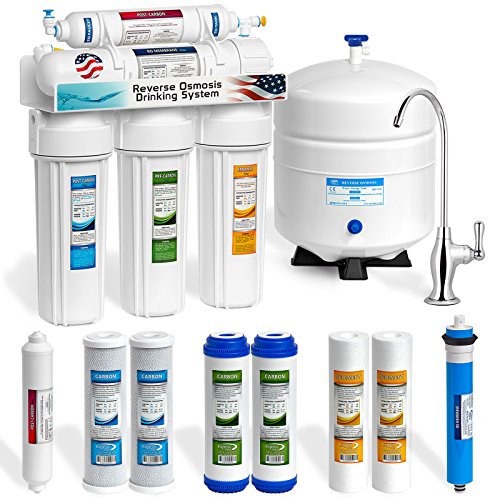 Price: Check on Amazon
Price: Check on Amazon
Pros:
- Excellent filtration with coconut shell carbon filters at three different stages of the filtration process
- Quick and easy installation, using color-matched Quick Connect fittings for additional ease
- Quality construction
- Reasonably priced
Cons:
- Degradation of plastic fittings over time and possible leaks from the initial installation
Express Water’s RO5DX 5 Stage Reverse Osmosis System features the highest quality materials for the best filtration, to provide the finest quality water for your needs. Installation is not just quick or easy but foolproof as well, with the Quick Connect fittings color-matched to make mistakes near impossible.
The different phases of its five-step filtration are as follows:
- The first stage is a 5-micron sediment filter for removing particulates and other larger solids — removing dirt, sand, mud, silt, scale and rust from the source water. This filter itself is composed of thermally bonded polypropylene microfibers, melt-blown rather than woven, for added capacity which increases the lifetime of each cartridge and makes changes less frequent.
- 2nd Stage: G.A.C. Filter – The Granular Activated Carbon filter cartridge is made of 100% Pure Coconut Shell Carbon and features a 5 um nominal micron rating. Removes chlorine, organic chemicals, suspended particles, unnatural tastes and odors, dirt and other chemicals found in tap water.
- 3rd Stage: Carbon Block – The Carbon Block CTO is also made of 100% Pure Coconut Shell Carbon in a “block” construction and features a 5 um nominal micron rating. Removes chlorine, organic chemicals, suspended particles, unnatural tastes and odors, dirt and other chemicals found in tap water.
- 4th Stage: Reverse Osmosis Membrane (50 GPD) – The semipermeable Membrane element removes up to 99% of aesthetic and health-related contaminants. Removes Bacteria, Viruses, Pesticides, Ai, Pb, Cd, Hg and Total Dissolved Solids including many other unhealthy contaminants.
- The fifth and final stage is post-filtration by means of the coconut shell carbon inline filter. This is where the water is ‘polished’ or farther filtered post-membrane, to provide the cleanest drinkable water for your needs.
Note that the RO5DX includes top-shelf coconut shell carbon at three — yes, three — different stages of filtration, two before the RO membrane and one afterward to ‘polish’ the water post-filter. This is the best kind of carbon filtration one can ask for in domestic filtration.
The difference in filtration between this system and its immediate competitors is slight, but in water quality and taste, this quantum leap makes all the difference.
The RO5DX comes with a complimentary extra set of four replacement filter cartridges, missing only a replacement RO membrane cartridge.
Express Water’s filter cartridge packs cost $59.99 for a set of one each of the cartridges for the different non-RO stages and one RO membrane cartridge or $69.99 for a full three-year pack, excluding RO membrane cartridges. Even though you have to buy the RO membrane cartridge separately, this works out much cheaper.
The Quick Connect fittings might give customers pause, given their propensity to degrade (or simply leak, even before the fittings begin to perish). However, Express have two answers to this problem which should give the utmost reassurance to prospective customers:
- One is their extensive testing of each system. Each unit is pressure-tested, air-leak-tested and tested over time for cycle resistance to make absolutely sure your system isn’t leaky when you receive it.
- Then there’s the Leak Stopper included with the system, which automatically shuts off the intake valve when it detects that it’s come into contact with water
This added peace of mind can make a night-and-day difference when you’re undertaking to install a new water filter system.
The RO5DX is a quietly persuasive system. It doesn’t claim to be much, but it’s a product of which its manufacturer, Express Water, can be rightfully proud. Three stages of coconut shell GAC filtration allow this inexpensive system to punch above its weight — and land those punches too.
Best Reverse Osmosis System in the price range, $200 and under
This first range is probably the hardest in which to find a ‘winner’. It all depends on the customer’s needs and which edge one wishes to emphasize. The RCC7 probably comes out the worst as it has no pronounced ‘edge’ against the others. Arguments could be made in its favor if not for the fact that it has unjustifiably the highest price-point in the range.
The RO5DX probably has the best filtration by a hair’s breadth, with those three GAC filters. On the other hand, RCC7 Global Water’s offering is the cheapest and has a good amount of spares, which might just tip the field in its favor for the more budget-conscious customer.
Nevertheless, in terms of getting as much bang as possible for your buck, the RO5DX wins by a nose.
The Best Reverse Osmosis System Between $200 and $300
This is the range in which the products diversify a little more, even though most of them in this case are from the same manufacturer, namely APEC. We’ll begin with the ROES-50, their Top Tier Ultra water filter system.
APEC Top Tier Ultra Safe Built in USA Reverse Osmosis Drinking Water Filter System (ESSENCE ROES-50)
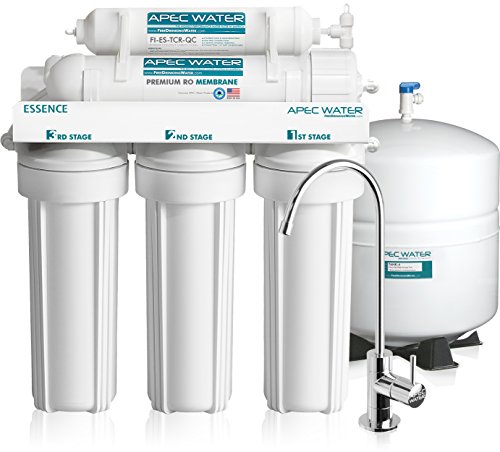 Price: Check on Amazon
Price: Check on Amazon
Pros:
- Quickly and easily installed with John Guest® Quick Connect fittings
- Filtration up to 99%, as certified by NSF and gold certified by WQA
- Flow-rate is double the average for RO
- Filters last twice as long
- Includes JG tubing and fittings, approved as safe and sanitary by the FDA and NSF
Cons:
- Despite its performance advantages, it’s still limited to the same scope and uses as other domestic RO systems
- Eventual degradation of tubing and JG connectors, also possible leaks from initial installation onward
APEC Water Systems’ ESSENCE ROES-50 is another five-stage filtration system. It’s also another product which the manufacturer markets prominently as Made in America, as per the aforementioned pattern. APEC’s five-stage filtration is a little different and goes as follows:
- The sediment filter comes first and tackles the larger solids like sand, silt, dirt, mud and so on, which would saturate the surfaces of the other filters and block them.
- This is followed by a double-capacity CTO carbon block filter for finer solids, chemicals and other contaminants.
- Third, another carbon block filter removes even more chemicals and solids.
- The RO membrane comes in here, as is of course typical in multi-stage RO systems.
- Finally, there’s the refinement by GAC activated coconut shell carbon inline filter, which ‘polishes’ the water and removes any leftover contaminants from the tank to provide the cleanest possible water at the faucet.
Not only are the carbon block filters double-capacity; APEC takes the surface chemistry of its filters to the limit for domestic filtration. This allows both more contact time with harmful chemicals like chlorine and also more surface area to hold contaminants, which allows extra capacity without doubling the volume of the cartridge. APEC’s the only manufacturer featured this time who will guarantee up to 99.999% removal of chlorine, chloramines and other totally water-soluble chemicals.
APEC’s five-stage filter packs are a little pricey at $74.95 for a single set of cartridges, but this will get you everything including the RO membrane cartridge. Keeping this in mind, the price makes sense.
APEC US Made Portable Countertop Reverse Osmosis Water Filter System (RO-CTOP) Installation-Free, fits most STANDARD FAUCET
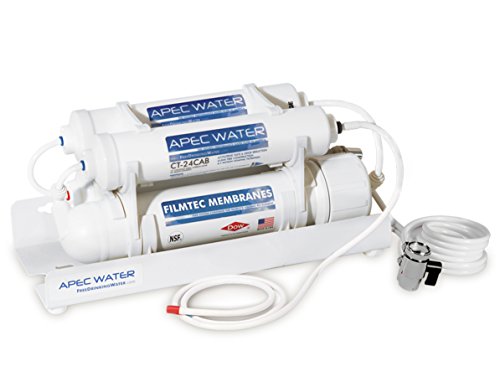 Price: Check on Amazon
Price: Check on Amazon
Pros:
- Fantastic filtration for portable requirements
- Flow-rate to tank is 90GPD
- Works in the 40psi to 80psi range
- Suitable for RVs, holiday homes, time-shares and similar applications
- Well-priced for the convenience
Cons:
- Fittings aren’t made for constant heavy-duty or long-term use
- Doesn’t work well outside its small recommended pressure range
Water filtration is a market in which customers should never be surprised to find wheels within wheels or niche specialties within niche specialties! Health- and flavor-conscious customers know all too well that not everywhere will be guaranteed to have filtration sufficient for their needs. When you’re working away, traveling, going on vacation or similarly away from home and mobile, portable filtration is a must. That’s exactly what this system promises.
The Portable RO-CTOP’s four-stage process works like this:
- First, the RO-CTOP feeds the mains supply water through the 5-micron ‘Quick Connect’ sediment filter. This captures silt, sand, dirt, mud, rust, scale and other larger particulate or insoluble solids.
- The GAC activated coconut shell carbon ‘Quick Connect’ filter then removes chemicals like arsenic, chlorine, chloramines and fluorides; fine solids and TDS; volatile organic compounds (VOCs) and other harmful contaminants from the filtered water.
- The world-class FILMTEC (Dow Chemical) TFC high-rejection RO membrane. Removes up to 99% of total dissolved solids (TDS) and contaminants such as arsenic, lead, fluoride, chromium, radium, bacteria, viruses and much more.
- Finally, the GAC activated coconut shell carbon ‘Quick Connect’ inline filter -removes any possible residual tastes.
Despite being only a portable four-stage filtration system, the RO-CTOP has GAC filtration at two of those stages, not to mention Dow’s FILMTEC high-rejection membrane for reverse-osmosis, arguably the best RO membrane in the world for the domestic consumer. All of this offered in one cheap, portable package is sure to please the customer with mobile water requirements.
APEC’s cartridges don’t come with a lot of package options. So, customers seem to be stuck with the option of an expensive set of cartridges at $127.95, albeit this includes the top-of-the-line FILMTEC membrane from Dow, so it’s worth the expense.
APEC Top Tier Alkaline Mineral Ph+ Ultra Safe Built In USA Reverse Osmosis Drinking Water Filter System (ESSENCE ROES-PH75)
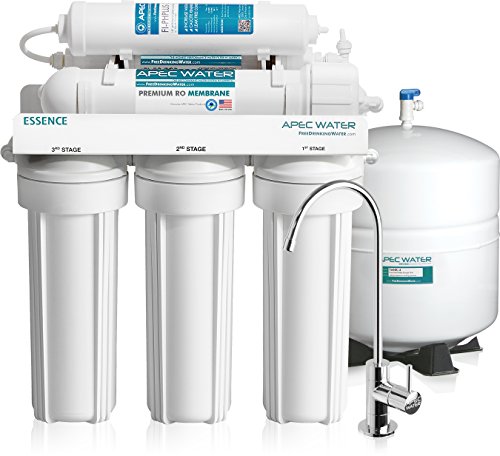 Price: Check on Amazon
Price: Check on Amazon
Pros:
- Excellent filtration with Dow FILMTEC membrane for world-class RO filtration
- Plumbs into mains securely with durable compression ring fittings
- Remineralizes with food-grade calcium
Cons:
- Installation requires more work and higher skill-level
This system’s six stages are as follows:
- 1st stage: high-capacity polypropylene sediment filter -removes dust, particles, and rust. Protects and extends the life of the membrane and system.
- The first CTO carbon block filter removes much of the distasteful and malodorous pollutants and chemicals, like chlorine and chloramines, from the water, as well as VOCs, some metal content, TDS and other harmful or unpleasant contaminants.
- A secondary carbon block filter provides additional filtration for more of the same.
- This is where the RO membrane enters the process. APEC’s TFC membrane eliminates up to 99% of TDS and chemicals like arsenic, chlorine, fluorides and metals like chromium and lead, radiological hazards like radium, as well as unsavory micro-organisms of all different kinds.
- Fifth comes the post-filtration by GAC coconut shell TCR carbon filter. This gives the filtered water a final polish by stripping most of the remaining contaminants from the water.
- The calcite remineralizing cartridge infuses the filtered water with calcium carbonate and makes the water slightly alkaline, rather than acidic.
After the first five stages, the water is as clean as possible as it comes into contact with the calcite cartridge. It has, at this point, as few possible undesirable contaminants and yet decent mineral content.
As mentioned above, APEC cartridge sets don’t seem to come in a lot of varieties, so customers will have to do some shopping around to get the pack they want at the price they want. You’ll probably have to mix and match: either the five-stage filter pack and a separately sourced FILMTEC membrane or else APEC’s four-pack at $127.95 with perhaps an additional carbon filter from APEC itself or some other manufacturer.
APEC Top Tier Supreme Certified High Flow 90 GPD Ultra Safe Built in USA Reverse Osmosis Drinking Water Filter System (ULTIMATE RO-90)
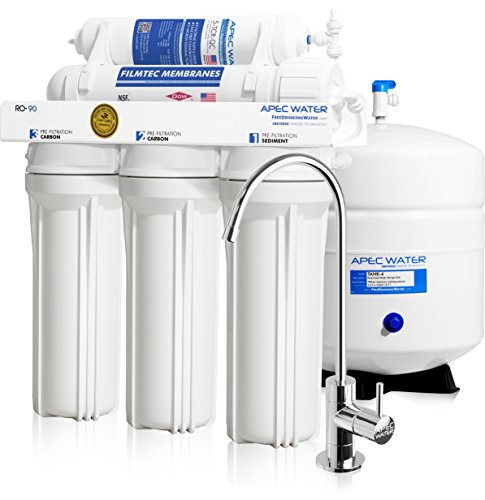 Price: Check on Amazon
Price: Check on Amazon
Pros:
- Excellent filtration with Dow FILMTEC membrane for superior RO filtration
- Top performance flow-rate to tank of 90GPD
- Plumbs into water main with a sturdy metal compressible fittings.
Cons:
- Price
- Installation requires more work and higher skill-level
The Top Tier Supreme offers the same as the unit above, but with a higher flow-rate and without the remineralization. This is for customers who require a more voluminous supply for the storage tank with no extra fuss or muss after the fact.
These are the stages of this water filter:
- First, larger solids are caught in APEC’s 5-micron high-capacity polyprop sediment filter cartridge. This includes dust, rust, sand, mud and a range of other particulates.
- Second, the 5-micron extruded carbon block technology filter effectively removes harmful, malodorous or unpleasantly flavored chemicals such as chlorine and also filters out VOCs.
- Another carbon block filter does more of the same at the third stage, for even less harmful organic content or unsavory chemicals.
- Fourth, the Dow FILMTEC TFC high-rejection RO membrane removes 99% of TDS; metals like chromium, lead and radium; chemicals such as arsenic, chlorine, chloramines and fluorides; as well has undesirable bacteria, viruses and other contaminants.
- Finally, the GAC activated coconut shell carbon “TCR (Total Contamination Removal” inline filter eliminates residual flavor-altering contaminants from the tank itself.
Really, what the Top Tier Supreme system from APEC offers is market-leading filtration without bells and whistles. It doesn’t boast much beyond its “Total Contamination Removal”, but then it doesn’t really have to do so in order to please filtration purists (pun intentional).
The same options for replacements that apply to the other APECs also apply here. Customers can price-check and shop around accordingly. So long as the cartridges are replaced in a timely fashion and the FILMTEC membranes are always replaced with the same and treated well, the filtration will be to the highest standard imaginable for the domestic RO market.
iSpring RCC7AK 6-Stage Under-Sink Reverse Osmosis Drinking Water Filtration System with Alkaline Remineralization Filter – 75 GPD
Price:Check on Amazon
Pros:
- Excellent filtration, with two stages of GAC filtration (including post-filtration)
- Certified by NSF and gold certified by WQA
- Feed connection adapter fits both ½” NPT and 3⅜” COMP connecting pipes
- 75 gallon-per-day filtered supply
- Remineralization and flavor enhancement
- Includes brushed-nickel-plated, solid brass, European-style faucet
- One-year money-back guarantee & one-year limited warranty
- Lifetime technical support
Cons:
- Insubstantial plastic fittings, more prone to wear and leaks
The RCC7AK stands out against the rest of manufacturer iSpring’s RCC7-based line. It comes with the same extras, boasts a 75GPD supply to tank and top-line post-filter remineralization.
Indubitably, this system achieves the best remineralization of any product reviewed here. It restores calcium, magnesium, potassium and sodium to the filtered water, compared with the Home Master systems below, which remineralize with only the first two of the four, and the APEC filter above which adds only calcium carbonate.
Most of the cartridges for this system are most easily replaced with iSpring’s six-stage filter packs: these come in 1-, 2- and 3-year packs. These cost $79.66, $152.57 and $221.69 respectively, available on Amazon. For the same reasons of cartridge lifetime we saw with the RCC7, the one-year packs don’t include RO cartridges, whereas the two- and three-year packs do. The three-year is the best deal, as it is in the case of the RCC7’s five-stage, three-year pack as well.
For another $79.99, customers can also purchase iSpring’s own-brand PMP5 pump to install with this system. The PMP5 pump is made for iSpring’s 75GPD systems, which include both this system and the simpler RCC7 reviewed above. Combining the action of the pump-fed RO with the remineralization at the sixth stage of the RCC7AK would really take this system to the next level and barely pushes the customer’s costs above $300.
Best Reverse Osmosis System in the range, $200 to $300
Of course, for portable needs, the APEC portable four-stage water filter is best. Nevertheless, the best filter overall in this range is the iSpring RCC7AK. It offers some of the best filtration with the most comprehensive remineralization process of any product reviewed. It’s also fantastically priced at $223.09.
The Best Reverse Osmosis System for $300 and Over
This is where we expect to find the slightly higher-end offerings.
Home Master TMAFC Artesian Full Contact Undersink Reverse Osmosis Water Filter System
Price: Check on Amazon
Pros:
- Installs quickly and easily under the sink and it can be mounted unobtrusively
- Fantastic flow rate for RO, roughly double normal RO rate
- Filtration up to 98% for metals, TDS and harmful or unpalatable chemicals
- Remineralization and flavor enhancement
- Quick and easy replacement of filters
Cons:
- Despite its performance advantages, it’s still limited to the same scope and uses as other domestic RO systems
Home Master offers an RO system designed to avoid the typical pitfalls of its filtration format. It’s one of the easiest units to install and almost certainly the easiest one for which to replace membranes and filter cartridges, as they just ‘click’ in and out, by design.
The system only needs to be mounted underneath the sink and it plumbs right into the line quickly and with ease. After the initial installation, cartridges only need to be switched in and out directly, which can be done almost at arm’s length and one-handedly. This eliminates the messing around under the sink that puts many customers off RO in the first place.
Filtration per se is not where this unit outshines the others. Rather, the flow rate through the membrane is about twice as fast as is standard for RO systems, which is where Home Master claims a good part of the bragging rights for this system. This is an unusual advantage for RO and gives it an edge against competitors, as well as an appeal to customers who normally don’t opt in for RO filtration.
Besides flow rate, the TMAFC does something else which is unusual for RO systems: it remineralizes the water with calcium and magnesium at two points in the system, first as the water reaches the water tank and second as it passes through the faucet. This means that the water is alkaline rather than acidic and has a drastically improved taste over its competitors in the RO market.
The filtration cartridges integrate both the filter and the filter housing in one disposable unit. This eliminates worries about build-up of solids and contaminants in the filter housing or even damage to the housing. So, the design foregoes the need for checking and replacing the housing for wear or other damage after several cartridge lifetimes.
Supposing one could sum up the advantages of this sort of system in a line, it would be the old saying that “prevention is better than cure”. The problems usually associated with RO systems were solved by simply avoiding them and eliminating the conventional design features which cause them. In the case of other issues, like acidity and taste of water, the system compensates through the aforementioned remineralization process.
On the downside, this system is only made and marketed for undersink use. It could, of course, be modified and extended to serve as a whole house system, but it wouldn’t be desirable for an RO system, however high-performance; even with these changes, its vaunted double flow-rate wouldn’t be enough to serve the usable water supply needs of an entire household. So, it has considerable advantages, but only against other RO units and only within the usual realm of domestic RO uses. Its flow-rate is remarkable relative to other RO systems, but still slow by the standards of the domestic plumbed-in filtration market in general.
The overall selling point of the TMAFC is that this system achieves the seven stages of filtration and mineral enhancement with a better, rather than worse, flow rate. It can boast both advantages, rather than having one at the expense of the other. For this uniquely robust and pronounced advantage, will be well worth the three-hundred dollar price tag to those satisfied customers looking for drinkable water without the wait. Simply put, this system defies the expectations of RO by exceeding them.
Home Master TMAFC-ERP Artesian Full Contact Undersink Reverse Osmosis Water Filter System
 Price: Check on Amazon
Price: Check on Amazon
Pros:
- Filtration up to 98% — possibly more — for metals, TDS and harmful or unpalatable chemicals
- Installs quickly and easily under the sink and it can be mounted unobtrusively
- Flow rate through the membrane is even better than the regular non-pump TMAFC, at nearly three times the normal RO rate
- Non-electric pump doesn’t require an external source of power
- Remineralization and flavor enhancement
- Quick and easy replacement of filters
- Better water pressure than ordinary non-pump-fed RO
- Wastes about 80% less water
- Prevents recontamination by TDS creep
Cons:
- Slightly more expensive
- Despite performance advantages, it’s still limited to the same scope and uses as other domestic RO systems
Another system from Home Master, this one costs a little more but offers a lot more in return. The TMAFC-ERP, like its less sophisticated sibling the TMAFC, defies expectations and overcomes flaws in construction by avoiding them at the design stage. It’s just as easy to install and equally hassle-free to replace cartridges, which just twist and click into place.
Of course, the sole substantial difference between the TMAFC and the TMAFC-ERP is the pump. It makes all the difference, though. The flow through the membrane is drastically improved.
The pump improves filtration as well, since the pressure feeding the membrane causes the hydrostatic pressure on the soluble contaminants to exceed the osmotic pressure which keeps them dissolved in the water. This allows the membrane to work more effectively by simply making solids and other contaminants easier to ‘catch’.
Pump-fed RO works on both smaller and larger scales. Industrial RO uses what’s in principle the same technology as Home Master’s TMAFC-ERP, which is why the RO filtration during industrial water treatment is so effective in removing contaminants during treatment. All else being equal, pump-driven RO filtration will always perform considerably better than non-pump-driven RO filtration, because the same chemistry and fluid mechanics always apply.
Another advantage of pump-feeding the filter is that it prevents TDS creep. This is a phenomenon where the water is recontaminated after it’s been filtered. Since the water is no longer moving — such as in a full water tank, for example — the hydrostatic pressure drops below the osmotic pressure enough to allow contaminants to leach from the membrane back into the filtered water on the other side.
The Home Master TMAFC-ERP’s pump is always feeding the filter. This means that there’s never a time while the system’s connected that the osmotic pressure is equal to (not to mention higher than) the hydrostatic pressure forcing the water through the membrane and the contaminants out of the water, onto the membrane.
The TMAFC-ERP has the same certification as the TMAFC above. For this reason, the manufacturer doesn’t make specific claims about its superior filtration and would be on shaky ground if they attempted to do so. Nevertheless, if you have two identical RO membranes each in a pump-fed and a non-pump-fed system respectively, the former will outperform the latter.
RO filters always work better at higher pressures compared with lower. Any TDS meter will confirm this ten times out of ten unless a filter, a fitting or the meter itself is broken. That’s just science. So, the TMAFC-ERP will be at the peak of domestic RO performance, even if the manufacturer declines to make the claim explicitly.
APEC Top Tier Supreme High Efficiency Permeate Pumped Ultra Safe Built in USA Reverse Osmosis Drinking Water Filter System For Low Pressure Homes (ULTIMATE RO-PERM)
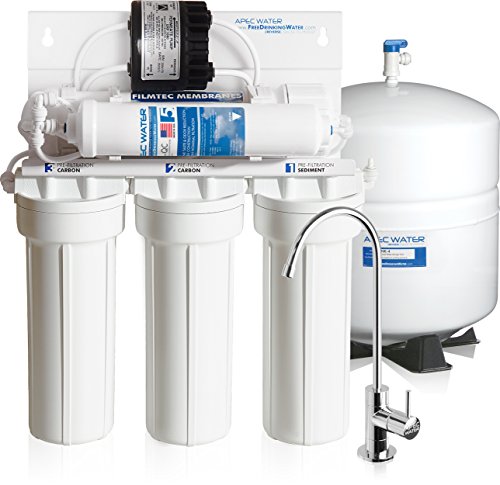 Price: Check on Amazon
Price: Check on Amazon
Pros:
- Excellent filtration
- Functions efficiently even with low feed pressure from mains source
- Permeate pump improves effectiveness of RO membrane
Cons:
- The most expensive product reviewed in this or any range
- May need the correct tubing and the addition of a shut-off valve to function properly and achieve the desired pressure and flow-rate
APEC’s Top Tier Supreme High Efficiency RO water filter is perfect for homes with low pressure water mains. This permeate pump-fed system delivers clean water at decent pressure and flow-rate to both the tank and faucet.
It installs about as easily as the other APEC systems, although there’s the added step of installing the pump.
Once it’s installed and functioning, the Top Tier Supreme RO filter system pumps source water through the following five-stage process:
- High-capacity polyprop sediment filter removes rust, scale, sand, mud, along with other sediments and larger solids.
- Extruded Carbon Block filter eliminates unpalatable metals, chemicals and VOCs for clean, clear water.
- Another extruded Carbon Block filter repeats this process.
- The fourth stage, the RO filtration, uses Dow’s FILMTEC TFC high-rejection RO membrane to removes up to 99% of TDS and other fine solids; metals like chromium-6, lead, mercury and radium; chemicals like arsenic, chlorine, chloramines and fluorides; as well as undesirable bacteria and viruses.
- Advanced GAC activated Coconut Shell carbon refining filter for TCR removes much of the remaining contamination remaining or leached in the tank, for clean water at the faucet.
This system is like the other APEC products reviewed above, albeit with the addition of the pump. It filters superbly and supplies a reliable stream of pressurized, clean water for low-pressure homes.
Some customers have trouble with the fittings and especially getting appropriately sized tubing, but a trip to the hardware store will remedy this quickly.
It’s expensive too, but all in all a fantastic product.
The Best Reverse Osmosis System in the range of $300 and Over
It’s easier to say what the loser in this range is — relatively speaking — than the winner. Home Master’s non-pump-fed TMAFC is operating at a handicap next to the two systems with the permeate pumps. So, the best in this range is either going to be Home Master’s TMAFC-ERP or APEC’s Top Tier Permeate Pumped water filter. Price-wise, fifteen dollars isn’t much of a difference — even less when we consider what fraction that is of either system’s total price.
Whatever way we cut it, the TMAFC-ERP from Home Master really comes out ahead. Not only is it cheaper, it has the additional step of remineralizing the filtered water after the fifth stage, an additional step which the APEC Top Tier Supreme lacks.
Which is the Best Reverse Osmosis System of them all?
The products which qualify for this final consideration are those which came out ahead in each of the three ranges. These ‘qualifiers’ have left us with Express Water’s RO5DX reverse osmosis system, iSpring’s RCC7AK alkaline remineralization filter and Home Master’s TMAFC-ERP.
Besides these three, again, APEC’s portable system, the RO-CTOP, is obviously the best for mobile water filtration, but this is more of a side-consideration, as we’re looking at the best of what’s on offer for this year in filtration.
Considering the three side by side, the TMAFC-ERP is the best system overall. It may be expensive at $350 — the second most expensive reviewed — but it’s worth every penny. It offers thorough filtration, decent remineralization (albeit not the best considered here, but not the worst either), and the all-important pump-fed RO filtration. Outside of the APEC Top Tier Supreme (which also has the permeate pump), the nearest competitors might rival its performance if the customer’s willing to attach a pump to them, but such pumps don’t come packed with these other systems like they do with the TMAFC-ERP for one reasonable, all-inclusive price.
This lets the TMAFC-ERP come out on top as the ‘best in show’ in this group review for 2017. None of these systems we’ve looked at will fail to meet the customer’s expectations, but perhaps only this one will smash them.
We welcome any feedback you have about any of the products or the review itself. Remember to watch this space for more reviews of the best water filter systems available as the year progresses.



